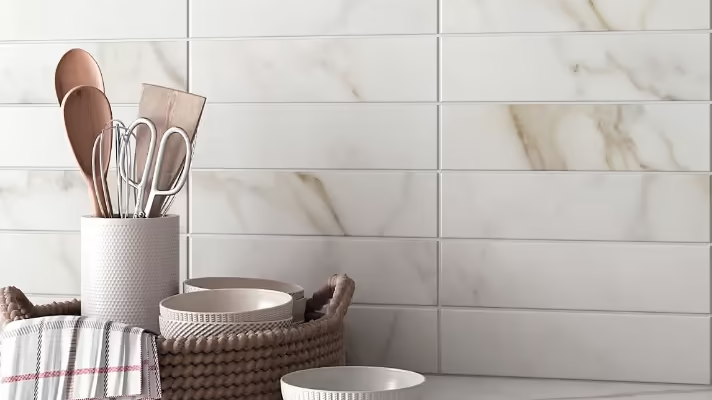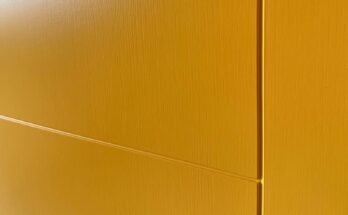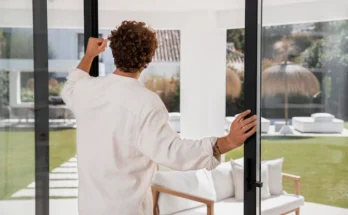Let’s be honest, for a long time, the subway tile has been the undisputed champion of the kitchen backsplash. And it’s easy to see why. It’s clean, it’s classic, and it’s safe. It’s the little black dress of kitchen design—you can’t really go wrong. But sometimes, “can’t go wrong” can start to feel a lot like “playing it safe.” If you’re looking at your kitchen and feeling a desire for something with more personality, something that truly reflects your style, then you’ve come to the right place.
What if your backsplash could be more than just a protective wall? What if it could be the main character of your kitchen, a piece of art that makes you smile every time you walk into the room? The good news is that the world of tile and design is full of stunning, elegant, and wonderfully unique alternatives that can take your kitchen from standard to spectacular.
Stepping away from the familiar can feel a little scary, but it’s also incredibly exciting. This article is your friendly guide to the beautiful world beyond subway tile. We’ll explore different materials, colors, shapes, and textures that can add a dose of drama, a touch of warmth, or a splash of whimsy to your space. So, let’s dive in and discover the backsplash that’s waiting to tell your story.
Why Look Beyond Subway Tile?
First, it’s important to say that there’s nothing wrong with subway tile. Its popularity is well-earned. But exploring other options is about more than just being different. It’s about intentional design.
Choosing a unique backsplash allows you to:
- Express Your Personality: Your home should be a reflection of you. A bold, textured, or colorful backsplash can say a lot about your style, whether it’s modern, rustic, romantic, or eclectic.
- Create a Focal Point: In a sea of cabinets and countertops, a stunning backsplash can draw the eye and become the centerpiece of the entire kitchen.
- Add Depth and Dimension: Many alternative materials bring texture and movement to a wall that a flat, smooth tile simply can’t.
- Make a Design Statement Without a Full Renovation: Updating your backsplash is one of the most impactful, yet relatively manageable, changes you can make to your kitchen. It can completely refresh the entire space without the need for new cabinets or appliances.
Think of your backsplash as your kitchen’s signature accessory—the statement necklace or the favorite scarf that pulls the whole outfit together.
The World of Wonderful Materials
One of the most exciting ways to break from tradition is to explore backsplashes made from materials you might not have considered for a kitchen wall.
1. The Timeless Elegance of Natural Stone
If you want a backsplash that has character and a one-of-a-kind look, natural stone is a fantastic choice. Unlike manufactured tiles, no two pieces of stone are exactly alike, which means your backsplash will be completely unique to your home.
- Marble: For centuries, marble has been a symbol of luxury and elegance. Its soft, flowing veins in shades of gray, white, or even green can add a touch of classic sophistication. A marble backsplash pairs beautifully with both light and dark cabinets. The important thing to know about marble is that it’s a soft and porous stone. It can stain and etch from acidic liquids like lemon juice or vinegar. Some people see this as a drawback, but others love the “lived-in” patina it develops over time, which adds to its character. If you prefer a pristine look, you’ll need to be diligent about sealing it and cleaning up spills quickly.
- Slate: If your style leans more towards rustic or modern farmhouse, slate could be your perfect match. It has a naturally textured, slightly rough surface that adds incredible depth and a tactile quality to the wall. Its color palette is typically rich and dark, featuring shades of charcoal, black, deep purple, and green. It’s also much more durable and stain-resistant than marble, making it a practical choice for a busy kitchen.
- Travertine: This stone offers a warm, old-world charm. It has a pitted, porous surface that can be filled and polished to a high shine or left in its more natural, honed state. Its colors are typically warm neutrals like beige, cream, and walnut. A travertine backsplash brings a sense of history and earthy elegance to a space.
2. The Warmth and Character of Brick
Exposed brick isn’just for downtown lofts anymore. A brick backsplash can inject a kitchen with instant warmth, texture, and a touch of industrial or rustic appeal. You can use real, thin brick veneers or modern tiles that mimic the look of brick perfectly.
The color of the brick and the grout you choose will define the look. White-washed brick can make a kitchen feel bright and coastal. Classic red brick brings a cozy, traditional feel. And dark gray or black brick can create a surprisingly modern and dramatic statement. The uneven surface and deep grout lines create a shadow play that changes with the light throughout the day, making the wall feel alive.
3. The Sleek Modernity of Metal
For a truly modern and sleek look, consider a metal backsplash. This is a bold choice that feels professional and clean.
- Stainless Steel: This is the classic choice for a commercial-style kitchen. It’s incredibly durable, heat-resistant, and easy to clean. It reflects light, which can help brighten a darker kitchen, and it pairs seamlessly with stainless steel appliances for a unified look. The downside is that it can show every fingerprint, water spot, and smudge.
- Copper: If you want a metal that adds warmth instead of coolness, copper is a showstopper. It has a beautiful, rich glow that develops a unique patina over time, darkening and changing color. This evolving nature means your backsplash will look different in a year than it does on day one, which is part of its charm.
- Pewter or Zinc: These metals offer a softer, more muted look than stainless steel. They have a subtle, brushed finish that is less prone to showing fingerprints and adds a touch of understated luxury.
Playing with Shape and Pattern
You don’t have to change the material to make a big impact. Sometimes, all it takes is a different shape or a creative pattern.
1. The Zellige Handcrafted Look
Imagine a tile that has a slight shimmer, subtle color variations, and an imperfect, wavy surface. That’s the magic of zellige-style tiles. These are often handmade or designed to look handmade, and they are all about celebrating imperfection. No two tiles are exactly the same, which creates a backsplash with incredible depth and movement. The glazes are often slightly irregular, catching the light in a way that makes the wall seem to glow. This is a wonderful way to achieve a sophisticated, artisanal look that feels collected and personal.
2. The Geometric Play of Hexagons, Penny Rounds, and Fish Scale
Why stick to rectangles and squares when there are so many other shapes to play with?
- Hexagons: The hexagon tile has made a huge comeback. It offers a cool, geometric pattern that feels both modern and timeless. You can find them in a single color for a subtle honeycomb effect, or you can create a stunning pattern by mixing and matching colors.
- Penny Rounds: These are small, circular tiles that come on mesh-backed sheets for easy installation. They have a wonderful, vintage feel that’s perfect for a retro or classic kitchen. They add a soft, bubbly texture to the wall.
- Fish Scale: If you’re dreaming of a bathroom-like serenity in your kitchen or want a touch of whimsy, fish scale tiles are a beautiful option. Their overlapping, organic pattern feels soft and fluid, reminiscent of the sea. They look particularly stunning in a soft, pearlescent glaze or a bold, contrasting color.
3. The Drama of Large-Format Slabs
On the complete opposite end of the spectrum from small mosaics are large-format slabs. Imagine a single, huge piece of stone, quartz, or even porcelain that stretches across your entire backsplash without a single grout line. The effect is incredibly sleek, seamless, and modern.
This approach makes a small kitchen feel larger and is unbelievably easy to clean. Using the same material for your backsplash and countertop is a major trend that creates a monolithic, high-end look. A large slab of dramatic marble or a bold, solid color can be the ultimate minimalist statement.
Making a Statement with Color and Texture
Sometimes, the most powerful change is the simplest one: stepping away from white and beige.
1. Go Bold with Color
Don’t be afraid to use your backsplash to inject a burst of color into your kitchen. A rich, jewel-toned tile like emerald green, sapphire blue, or deep burgundy can create a luxurious and intimate feel. A sunny yellow or a cheerful coral can make the kitchen the happiest room in the house. If painting all your cabinets a bright color feels like too much, letting your backsplash be the sole source of vibrant color is a perfectly balanced approach.
2. Embrace Texture
A backsplash doesn’t have to be smooth to be functional. Textured tiles can add a whole new dimension to your kitchen.
- Fluted or Rippled Tiles: These tiles have vertical grooves or waves that create beautiful lines and catch the light, casting soft shadows. This adds a sculptural, almost architectural element to the space.
- 3D Tiles: For the truly daring, three-dimensional tiles create a surface that you can’t help but touch. They can feature geometric patterns, organic shapes, or abstract designs that pop out from the wall. This is a surefire way to make your backsplash a conversation piece.
Tying It All Together: Design Tips for Success
With all these amazing options, how do you choose? And how do you make sure your bold new backsplash doesn’t clash with the rest of your kitchen? Here are a few simple tips.
- Consider Your Overall Style. Your backsplash should feel like a part of the kitchen, not a disconnected afterthought. A rustic brick backsplash might feel out of place in an ultra-modern, glossy kitchen. A sleek metal one might feel cold in a cozy farmhouse space. Look for an alternative that complements the style you already have.
- Use Samples, Always! This is the golden rule of any design project. Never, ever choose a tile from a picture on a screen or under the bright lights of a showroom. Order physical samples and tape them to your backsplash wall. Live with them for a few days. Look at them in the morning light, the afternoon sun, and under your kitchen’s overhead lighting at night. See how the color and texture look next to your cabinets, countertops, and floor.
- Balance is Key. If you’re going for a very bold, patterned, or colorful backsplash, you might want to keep the rest of your kitchen relatively simple. Neutral-colored cabinets and countertops will let your stunning backsplash truly shine. Conversely, if your cabinets are very ornate or colorful, a more subdued backsplash might be the way to go.
- Don’t Forget the Grout. The color of your grout can make or break the look. A grout color that matches your tile will create a seamless, uniform appearance, letting the shape and material take center stage. A contrasting grout color (like dark gray with white tile) will highlight the pattern and make each tile stand out, adding a graphic element.
Your Kitchen, Your Masterpiece
Your kitchen is the heart of your home. It’s where meals are prepared, homework is done, and conversations happen at the end of a long day. Shouldn’t this special space have a bit of your heart in it, too? Moving beyond the familiar subway tile is an invitation to infuse your kitchen with personality, creativity, and a style that is uniquely yours.
Whether you fall in love with the organic warmth of natural stone, the geometric fun of hexagons, the handcrafted beauty of zellige, or the bold statement of a colorful slab, there is a perfect backsplash waiting for you. It’s time to see that blank wall behind your counter not as a problem to be solved, but as a canvas for your next great design adventure. So go ahead, be a little daring. Your dream kitchen is waiting.




